(originated 23 May, 2010)
(updated 25 September, 2011)
What is a Chinook? Webster's defines it as: 1) an Indian Tribe of the Pacific Northwest, or 2) a dry, northwest wind of the Rocky Mountains. Not even close. Whoever designed and named this one must have had a twisted sense of humor. My Chinook is a miniature motor home. A camper shell built on the frame of a 1976 Toyota pickup. It's underpowered, overweight, so low to the ground it can barely clear speed bumps, has a pathetic use of space, crammed full of useless junk. But, I was without any car, desperately in need of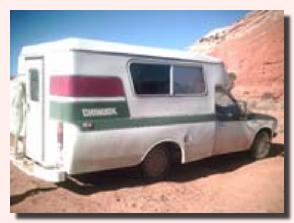 transportation, and a friend said I could drive it for the summer, 'free' - if I could get it running. transportation, and a friend said I could drive it for the summer, 'free' - if I could get it running.
When I first saw it, it was sitting abandoned in a field, needed tires, battery, and the inside was trashed. My first reaction was to walk away. This sure wasn't what I had in mind. But since nothing else was making itself available....decided I had to give it a try. After an afternoon's work, we did get it running and I drove it home.
Keeping it running became my summer's full-time challenge. It ran, and then it didn't. Started, and then wouldn't, and left me stranded on more than one occasion. Many times I felt like hauling it back just to get it out of my life....but then what? I still had nothing else for transportation. This seemed to be the only thing that was being provided, so I turned it over, kept the Chinook, kept fixing, and kept looking (and praying) for its replacement.
When this started I did know the basics of auto care - changing oil, checking tire pressure - but, that's about where my knowledge stopped. That wasn't good enough anymore. In my nomadic lifestyle where I must seek out remote, isolated sites where I can be free from electromagnetic and radio/microwave radiation, there isn't a nearby, handy mechanic (which, living with no income, I couldn't afford anyway). Nor are there any neighbors with which to share rides.
Fortunately, Gary Duncan is a pretty good mechanic, and over the course of the summer, taught me - system by system - how to repair and maintain this Toyota. Didn't think I'd take to it, but I actually (due to necessity) got pretty good at it and by the end of the summer had it running, not great, but at least fairly dependably.
Two months, and five hundred dollars later...summer was nearly over, I still had found nothing else to drive, had given the Chinook the beginning of a new life, thought it deserved better than to be abandoned again, and so I bought it. Took it to Utah for the winter to begin its transformation into what would be my new home.
As the toxification of the planet continues to escalate with more and more cell towers, smart grid, broadband, even wireless communication now being used to track truckers on highways and being run through underground gas lines, we as hypersensitives are having to go to more and more remote locations to find safe places in which to live without the constant bombardment of radiation.
The reality and difficulty of this dire situation became the inspiration for The Raven's Nest. Until that can happen, and we can start taking down the cell towers, get rid of the toxic radiation, and restore the living conditions on the planet, something else needed to happen.
The converted trailer I was living in can't do what we now need. (www.smartshelter.com/RFmicrohabitats.htm ) And so a new concept...the K-11, M2, Micro Habitat...a lightweight, safe, shielded, 4 wheel-drive, high-clearance, mobile domicile that can take us virtually anywhere.
Although the Chinook doesn't qualify in a lot of areas, it became the prototype. I stripped the inside, insulated and rebuilt it, built a new, insulated roof (one that I could stand up in), and after 4 versions, a stove for heat. I now heat my home with a section of heating duct and an RV stove burner.
With spring now returning to the desert, and the Chinook nearly done and running well, (this after I took apart the carburetor, cleaned it, and put it back together. (Yes, I really did. Only took me 3 days), so begins the saga of my new lifestyle. My first trip, to take Gary up-country to pick up his truck (on which to build his own M2), was a journey of less than 500 miles (round trip) that I took 10 days to make, arriving back in Utah in pretty good shape, and without being destroyed. A first for me. A journey like that before would have put me down for days, if not weeks, due to the exhaustion and pain caused by exposure to not only the magnetic fields from the vehicle, but all the toxic radiation from power lines, cell towers, etc., to which you are constantly exposed while on the road. But with the Chinook, I was able to take my time, find safe places to sleep, stay for a day or 2 when needed to recover, and be completely comfortable.
As time permits, I'll be posting the continued saga of the Chinook. Let's see where this can take me.....
Fall 2010.

I've just finished living the entire summer in the Chinook. Where did the time go? I've adapted well to the Chinook, and it's continuing to run great. A little temperamental, but aren't we all now and then...
Am just getting a taste of the freedom it's given me to travel, and have spent a lot of time in documenting the tree die-off - now proven to be caused by microwave/radio radiation. Yes, your cell phone is killing the planet. More on that in The Killing Fields.
Here are a couple of places I've been able to visit.
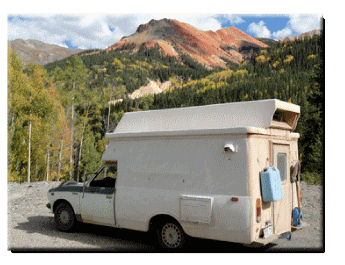 Those of you familiar with SW Colorado will recognize this spot as Red Mountain, just south of Ouray. A narow valley ending in an 11,000 ft. plus mountain pass of unparalleled beauty. A favorite spot of mine, especially in the fall when the aspen turn gold and shimmer against the blue sky and red mountains. A pretty tough climb for the Chinook, but made it without trouble, just a bit slower than most. Those of you familiar with SW Colorado will recognize this spot as Red Mountain, just south of Ouray. A narow valley ending in an 11,000 ft. plus mountain pass of unparalleled beauty. A favorite spot of mine, especially in the fall when the aspen turn gold and shimmer against the blue sky and red mountains. A pretty tough climb for the Chinook, but made it without trouble, just a bit slower than most.
Notice the new paint job on the Chinook. (If you can see it). That's elastomeric paint with ferrite mixed in. A black, fine, iron ore that is microwave absorbant. Mixed, not thoroughly, just enough to give it a sort of marbled look. Applied to not only look better, but help give a little shielding from radiation.
Valley of the Gods in southern Utah. 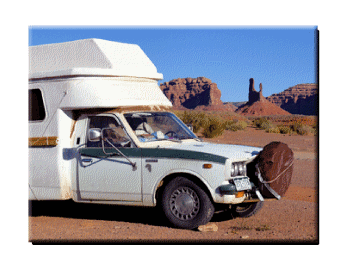
I spent 3 wonderful days here enroute (the scenic route) back to Moab this fall. I might add that all these pictures are possible because of a new digital camera purchased for me by Smart Shelter. While I had nearly given up on my photography because of the EMF radiation produced by the scanner, computer, and printer, this simplifies the task so much that I am looking forward to being able to continue this art form...in just a slightly different mode. Stay tuned to more pictures as I learn how to use this one.
Wondering where this little Chinook will take me next??? I'm planning on heading off for Arizona in just a few weeks - to spend the winter in a warmer climate. A journey of at least 500 miles (one way). Something I could only dream of before the Chinook and the shielding, remediation techniques we have developed.
Guess what? The Chinese were right. We now believe that the electro-magnetic/microwave raditaion is effecting us through our merdian system. This is what is causing our exhaustion, headaches, short-term memory loss and all the other ES (electro sensitive) symptoms. With grounding, and daily self massage, I can now speeden the disapation of the toxic radiation. Dramatically lessening those debilitating effects and shortening my recovery time. I no longer have to spend days/weeks recovering from a town trip. What a gift!

Winter 2010-2011
The first trip to Arizona
(November 5, 2010)
Well, I did it. I'm launched and on my way to Arizona for the winter.
First stop...back to Valley of the Gods for 4 days to rest and get ready for the rest of the journey. As an ES (Electro-Sensitive), I can't just pull off anywhere to sleep. We must locate 'safe' places along the way, and I have those, enough to get me to Flagstaff. From there, it's new and unknown (from an ES standpoint) territory. Wish me luck!
Next stop - Navajo National Monument. I've always wanted to see this, and have been in contact with one of the rangers there. She seemed to think their campgrounds woul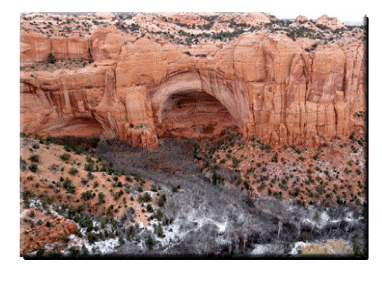 d be safe for me. However, not so. One was in direct line-of-sight to a whole array of towers. The other right next to their power line and living quarters. But, I was just way too tired to go any further, (and nowhere else to stop on the reservation). Spent a fairly decent night, with a little sleep. Thanks only to the shielding techniques we've developed. And woke to ....snow! And the promise of more to come. d be safe for me. However, not so. One was in direct line-of-sight to a whole array of towers. The other right next to their power line and living quarters. But, I was just way too tired to go any further, (and nowhere else to stop on the reservation). Spent a fairly decent night, with a little sleep. Thanks only to the shielding techniques we've developed. And woke to ....snow! And the promise of more to come.
Time to leave anyway and find somewhere safe. No tour of the ruins, so had to settle for a little hike (in the snow and cold) to an overlook. It's a system of incredible canyons and valleys, cliffs and alcoves. Breath-taking and beautiful.
Maybe some other time.....
For those not familiar with Navajo national Monument, this is the Anasazi ruin called Betatikin. Also in the Monument are the ruins of Keet Seel and nearby Inscription House.
Spent the next night north of Flagstaff, in a safe location. Had a wonderful night's sleep....YEAH!! But... woke to 16 degrees. BRRR! But,. nice and cozy with the heater in the Chinook. All the trials and time surely paid off on this one.
Should have stayed put and rested. Two full days of driving is pushing my limits. That would have been the smart thing to do, but didn't. Something was pulling me on. Weather forecast for Flagstaff was continued cold. Twenty degrees warmer in Sedona....just 45 minutes further south. Thought I could make it. And I did, but turned into a long, tough, painful day. Started going downhill with exhaustion, and still had to find a place to stay. That turned into a difficult task. Between the cell phone towers and power lines, this wonderful, red rock country is being radiated to death. And it shows. Everything is dying...just like the forests.
After driving and hiking...driving and hiking. And moving 4 times, I finally found a couple safe sites. Spent the next 2 weeks recovering and then enjoying the warm weather. It was fantastic and worth the trip.
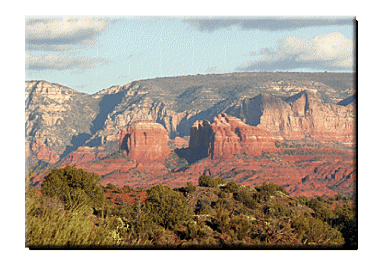 Those of you familiar with old western movies will recognize this... Cathedral Rock near Sedona. In Cottonwood, I got to attend a Contra Dance and meet a few of the locals. A great, fun evening. Those of you familiar with old western movies will recognize this... Cathedral Rock near Sedona. In Cottonwood, I got to attend a Contra Dance and meet a few of the locals. A great, fun evening.
From Sedona/Cottonwood area, I finally headed on through the town of Jerome, and then Prescott. (Cold and snowy. Trying to stay ahead of yet another storm). Winding, twisting roads. Gorgeous country. Would fit in Colorado just fine. And finally, at Yarnell, dropped down the Mogollon Rim into the Sonoran Desert and my first view of the majestic Saguaro.
November 29, 2010
Wickenburg!!!
Yes, I made it! I had thought it would take me a month. Should have, but didn't because of the weather. However, I made it in pretty good shape. Tired, but not exhausted. Had to spend another night in direct line-of-sight to cell towers (this one was tough) before I could find a safe site, but those sites are here. Now, the rest of the winter is before me to explore and enjoy this interesting country.
But....a very depressing discovery. Electro-Magnetic/Microwave Radiation is killing, not only the trees in Colorado, but the cactus/saguaro in Arizona. There truly is 'no living thing that is NOT reacting to this radiation'.
|

